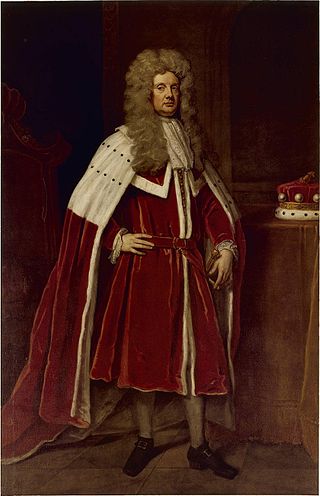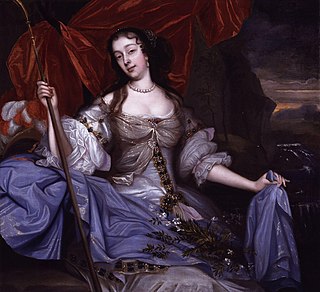
Baron Baltimore, of Baltimore, County Longford, was a title in the Peerage of Ireland. It was created in 1625 and ended in 1771, upon the death of its sixth-generation male heir, aged 40. Holders of the title were usually known as Lord Baltimore for short.

Sir Robert Eden, 1st Baronet was a British colonial administrator who was the last colonial Governor of Maryland. Although a popular governor and an able administrator, Eden's authority was overthrown by the events of the American Revolution, and in June 1776 he was invited by the Maryland Convention to leave for England. Eden was well-regarded at home and in the same year, 1776, he was made a baronet. He eventually returned to Maryland where he died in 1784 at the age of 42. He was buried in Annapolis and was succeeded in the baronetcy by his eldest son, Frederick, a noted author.

The Province of Maryland was an English and later British colony in North America from 1634 until 1776, when the province was one of the Thirteen Colonies that joined in supporting the American Revolution against Great Britain. In 1781, Maryland was the 13th signatory to the Articles of Confederation. The province's first settlement and capital was in St. Mary's City, located at the southern end of St. Mary's County, a peninsula in the Chesapeake Bay bordered by four tidal rivers.

Charles Calvert, 3rd Baron Baltimore was an English peer and colonial administrator. He inherited the province of Maryland in 1675 upon the death of his father, Cecil Calvert, 2nd Baron Baltimore. He had been his father's Deputy Governor since 1661 when he arrived in the colony at the age of 24. However, Charles left Maryland for England in 1684 and would never return. The events following the Glorious Revolution in England in 1688 would cost Calvert his title to Maryland; in 1689 the royal charter to the colony was withdrawn, leading to direct rule by the British Crown. Calvert's political problems were largely caused by his Roman Catholic faith which was at odds with the established Church of England.

Benedict Leonard Calvert, 4th Baron Baltimore was an English peer and politician. He was the second son of Charles Calvert, 3rd Baron Baltimore (1637–1715) by Jane Lowe, and became his father's heir upon the death of his elder brother Cecil in 1681. The 3rd Lord Baltimore was a devout Roman Catholic, and had lost his title to the Province of Maryland shortly after the events of the Glorious Revolution in 1688, when the Protestant monarchs William III and Mary II acceded to the British throne. Benedict Calvert made strenuous attempts to have his family's title to Maryland restored by renouncing Roman Catholicism and joining the Church of England.

Charles Calvert, 5th Baron Baltimore, was a British nobleman and Proprietary Governor of the Province of Maryland. He inherited the title to Maryland aged just fifteen, on the death of his father and grandfather, when the colony was restored by the British monarchy to the Calvert family's control, following its seizure in 1688. In 1721 Charles came of age and assumed personal control of Maryland, travelling there briefly in 1732. For most of his life, he remained in England, where he pursued an active career in politics, rising to become Lord of the Admiralty from 1742 to 1744. He died in 1751 in England, aged 52.

Frederick Calvert, 6th Baron Baltimore, styled The Hon. Frederick Calvert until 1751, was an English nobleman and last in line of the Barons Baltimore. Although he exercised almost feudal power in the Province of Maryland, he never once set foot in the colony, and unlike his father, he took little interest in politics, treating his estates, including Maryland, largely as sources of revenue to support his extravagant, often scandalous lifestyle. In 1768 he was accused of abduction and rape by Sarah Woodcock, a noted beauty who kept a milliner's shop at Tower Hill. The jury acquitted Calvert, but he left England soon afterwards, and never recovered from the public scandal that surrounded the trial. Dogged by the criticism and poor health, he contracted a fever and died in Naples at the age of 40.

Samuel Ogle was the 16th, 18th and 20th Proprietary Governor of Maryland from 1731 to 1732, 1733 to 1742, and 1746/1747 to 1752.

Charles Benedict Calvert was an American politician who was a U.S. Representative from the sixth district of Maryland, serving one term from 1861 to 1863. He was an early backer of the inventors of the telegraph, and in 1856 he founded the Maryland Agricultural College, the first agricultural research college in America, now known as the University of Maryland. He was a direct descendant of the Lords Baltimore, proprietary governors of the Province of Maryland from 1631 until 1776.

Benedict Leonard Calvert was the 15th Proprietary Governor of Maryland from 1727 through 1731, appointed by his older brother, Charles Calvert, 5th Baron Baltimore (1699–1751). He was named after his father, Benedict Calvert, 4th Baron Baltimore (1679–1715). Calvert had tuberculosis and died from it on board the family ship, The Charles, on 1 June 1732, while returning to his home in England, aged 31.

John Hart served as the 12th Royal Governor of Maryland from 1714 to 1715 and continued as the 12th Proprietary Governor of Maryland from 1715 to 1720, after the restoration of proprietary control to Charles Calvert, 5th Baron Baltimore. His governorship marked the beginnings of the restoration of the Calvert family's control of Maryland.
Calvert is a given name and a surname of English, Scottish and Northern Irish origin.

Richard Penn Sr. was a proprietary and titular governor of the Province of Pennsylvania and the counties of New Castle, Kent, and Sussex, which then included present-day Delaware. He served as governor from 1746 to 1771. His father was William Penn, founder of the colonial-era Province of Pennsylvania, one of the original Thirteen Colonies in British America

Charlotte Lee, Lady Baltimore (23 March 1678, – 1 February 1721,, was an English noblewoman, and granddaughter of King Charles II of England and his mistress Barbara Villiers. She married in 1699, Benedict Leonard Calvert, 4th Baron Baltimore, from whom she separated in 1705; she later married Christopher Crowe. She was the mother of Charles Calvert, 5th Baron Baltimore, and of Benedict Leonard Calvert, who was Governor of Maryland from 1727 to 1731.
George Hume Steuart, (1700–1784) was a Scottish physician, tobacco planter, and Loyalist politician in colonial Maryland. Born in Perthshire, Steuart emigrated to Maryland in around 1721, where he benefited from proprietarial patronage and was appointed to a number of colonial offices, eventually becoming a wealthy landowner with estates in both Maryland and Scotland, and serving two terms as mayor of Annapolis. However, he was forced by the outbreak of the American Revolution to decide whether to remain loyal to the Crown or to throw in his lot with the American rebels. In 1775 Steuart sailed to Scotland, deciding at age 75 that "he could not turn rebel in his old age". He remained there until his death in 1784.
Benedict Calvert may refer to:

Benedict Swingate Calvert was a planter, politician and a Loyalist in Maryland during the American Revolution. He was the son of Charles Calvert, 5th Baron Baltimore, the third Proprietor Governor of Maryland (1699–1751). His mother's identity is not known, though one source speculates that she was Melusina von der Schulenburg, Countess of Walsingham. As he was illegitimate, he was not able to inherit his father's title or estates, which passed instead to his half brother Frederick Calvert, 6th Baron Baltimore (1731–1771). Benedict Calvert spent most of his life as a politician, judge and planter in Maryland, though Frederick, by contrast, never visited the colony. Calvert became wealthy through proprietarial patronage and became an important colonial official, but he would lose his offices and his political power, though not his land and wealth, during the American Revolution.

Captain Charles Calvert was a British Army officer, colonial administrator and planter who served as the governor of Maryland from 1720 to 1727 at a time when the Calvert family had recently regained control of the Province of Maryland. He was appointed governor by his cousin Charles Calvert, 5th Baron Baltimore, who in 1721 came into his inheritance over the colony.

Elizabeth Calvert was the daughter of Maryland Governor Captain Charles Calvert and Rebecca Gerard, and a wealthy heiress in colonial Maryland. Her parents died when she was young, leaving her their substantial fortune. In 1748, aged 17, she married her cousin Benedict Swingate Calvert, a Loyalist politician and planter and the illegitimate son of Charles Calvert, 5th Baron Baltimore. Benedict's connections to the ruling Calvert family allowed him to benefit from considerable proprietarial patronage, until the American Revolution saw the overthrow of British rule and the end of Calvert power in Maryland. Benedict and Elizabeth had to pay triple taxes after the war's end but, unlike many loyalists, their lands and fortune remained unconfiscated.
Governor Calvert may refer to:
















